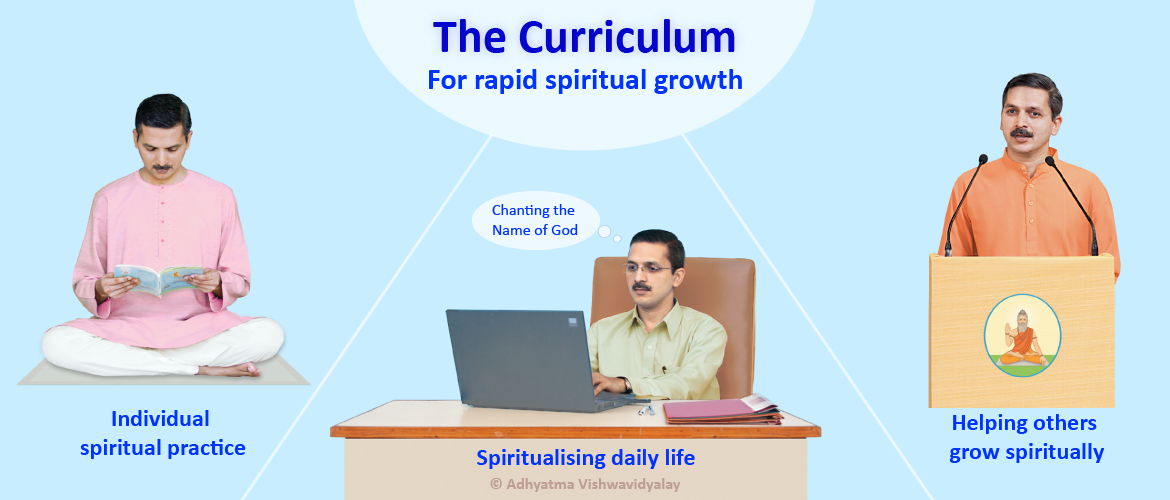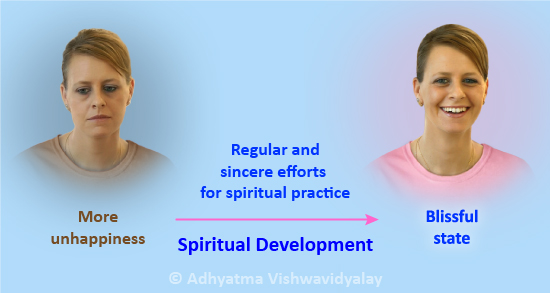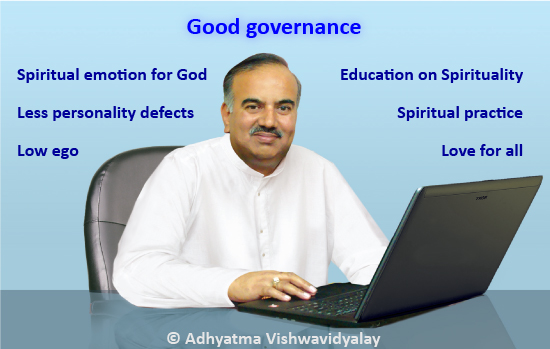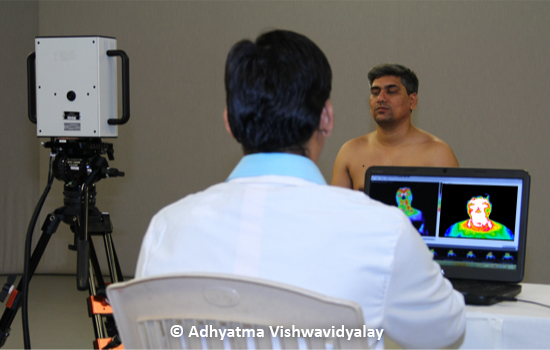 Objective of the curriculum
Objective of the curriculum
When prospective students think of applying to Universities nowadays, spiritual development is rarely a focus. Yet according to the science of Spirituality, spiritual development is one of the main reasons why we are born. This kind of spiritual development transcends any sectarian religious belief systems (that could be myopic or ethnocentric in their viewpoint) and needs to be of a universal nature, as God is universal.
1. Spiritualising life
When people think of God, they generally go to some place of worship or some religious institute. For most people, there are fairly clear lines drawn between their worldly life and their spiritual life. People behave in a certain way in a place of worship and they may behave quite the opposite at home or at work. The worldly life and spiritual life of an average person, rarely meet.
Under the aegis of the Maharshi University of Spirituality, students will learn how to blur these lines and make Spirituality a part and parcel of their worldly life. It will provide a true spiritual education, which will show seekers and society how to spiritualise every aspect of their lives, including whatever discipline or art they may want to excel in. Currently there is no university on Earth that provides such a focus in the curriculum provided to their students i.e., how to live Spirituality.
2. Spiritual development
 It is rare for a person to turn to Spirituality and become a seeker in the era of Kaliyug. However if due to their current spiritual guidance, seekers feel they have not progressed spiritually, or have not got higher and higher levels of spiritual experiences, or basically have not benefited from spiritual practice, then they can lose interest and faith in spiritual practice. As a result, years of a seeker’s life may be wasted. To ensure this does not happen the curriculum of this university will be designed to nurture seekers in their spiritual journey.
It is rare for a person to turn to Spirituality and become a seeker in the era of Kaliyug. However if due to their current spiritual guidance, seekers feel they have not progressed spiritually, or have not got higher and higher levels of spiritual experiences, or basically have not benefited from spiritual practice, then they can lose interest and faith in spiritual practice. As a result, years of a seeker’s life may be wasted. To ensure this does not happen the curriculum of this university will be designed to nurture seekers in their spiritual journey.
When a potter creates a pot, the potter and the pot are different. However in the case of God and His creation, this is not so. God is the only creator, Who is also part of His creation. This means that the God principle is infused to varying degrees in both inanimate objects and living beings and the entire unseen spiritual dimension. For seekers this means they have an opportunity to find God through every aspect of His creation. The Maharshi University of Spirituality will generate the ability in their students (seekers) to find God through His creation and through this facilitate their spiritual growth towards God-realisation. Sainthood is bestowed upon those seekers who through spiritual practice have attained a spiritual level of 70% and above. It is the resolve of H.H. Dr Athavale to create thousands of Saints from the Maharshi University of Spirituality.
3. Good governance
 The United Nations emphasizes reform through human development and political institution reform. According to the UN, good governance has eight characteristics. These are Consensus Oriented, Participatory, Following the Rule of Law, Effective and Efficient, Accountable, Transparent, Responsive, Equitable and Inclusive.
The United Nations emphasizes reform through human development and political institution reform. According to the UN, good governance has eight characteristics. These are Consensus Oriented, Participatory, Following the Rule of Law, Effective and Efficient, Accountable, Transparent, Responsive, Equitable and Inclusive.
From a spiritual standpoint such characteristics of good governance are merely superficial as human development and human behaviour are in fact underpinned by spiritual development. Regular spiritual practice which follows some universal principles can only bring about spiritual development and is the only factor that brings about lasting and intrinsic change in people’s behaviour for the better.
To bring spiritual purity (or sattvikta) into society, our leaders, administrators and social workers need to be sattvik themselves and have a firm grounding in Spirituality (Hindu Dharma). For this reason the Maharshi University of Spirituality will also teach topics that are useful in a person’s daily life such as Economics, Social Science, Political Science, Military Science, Jurisprudence and Literature. While such sciences are already taught in today’s universities, in the Maharshi University of Spirituality they will be taught in such a manner, which will make the student’s intellect sattvik or spiritually pure.
Guiding principles behind the curriculum for the Maharshi University of Spirituality
1. Using Modern Science to explain Spirituality
 Today’s generations rely more on scientific evidence. Spiritual development does not mean ignoring all the good work that has taken place in modern science. Accordingly to kindle an interest in Spirituality, the Maharshi University of Spirituality will use modern science and equipment wherever necessary, to help society better understand how to make choices in life that are spiritually purer in nature (sāttvik). Also by infusing spiritual understanding and spiritual principles in all modern science research and activities, we can obtain a far better and holistic outcome for the sustainable development of the world. So also to appeal to the modern generation, spiritual knowledge will be presented in a scientific manner, complete with comparison tables and graphs for easier comprehension of the spiritual impact of their choices.
Today’s generations rely more on scientific evidence. Spiritual development does not mean ignoring all the good work that has taken place in modern science. Accordingly to kindle an interest in Spirituality, the Maharshi University of Spirituality will use modern science and equipment wherever necessary, to help society better understand how to make choices in life that are spiritually purer in nature (sāttvik). Also by infusing spiritual understanding and spiritual principles in all modern science research and activities, we can obtain a far better and holistic outcome for the sustainable development of the world. So also to appeal to the modern generation, spiritual knowledge will be presented in a scientific manner, complete with comparison tables and graphs for easier comprehension of the spiritual impact of their choices.
2. God-realisation will be the focus
 When an artist undertakes a work of art, it is primarily for art’s sake alone. However according to Spiritual science or Hindu Dharma, ‘true art’ is that which awakens the seekership in a person and by which a seeker feels inspired to strive for spiritual growth. Accordingly whatever be the art or discipline, (be it drawing, idol-making, sculpting, drama, cookery, etc.) it must be for God-realisation.
When an artist undertakes a work of art, it is primarily for art’s sake alone. However according to Spiritual science or Hindu Dharma, ‘true art’ is that which awakens the seekership in a person and by which a seeker feels inspired to strive for spiritual growth. Accordingly whatever be the art or discipline, (be it drawing, idol-making, sculpting, drama, cookery, etc.) it must be for God-realisation.
Thus when a seeker of the Maharshi University of Spirituality undertakes a course in any field of art or discipline, he or she will be trained not to give importance to beauty and aesthetics alone, but also to imbibe spiritual purity (sāttvikta) into the art and oneself.
3. Tailor made to suit individual spiritual needs
We are all different and hence each of our paths to God will be different and unique. Yet most people who teach spiritual practice teach it as per the Spiritual Path known to them. This is akin to a doctor who gives one and the same medicine to all his patients. Due to this misunderstanding in those who teach Spirituality, seekers may not progress spiritually. The curriculum in the Maharshi University of Spirituality will therefore be tailor-made to cater to a seeker’s temperament and ability. Along with various Spiritual Paths, there will be some foundational subjects that would need to be undertaken by everyone for rapid spiritual growth. This will include reducing personality defects and ego and increasing bhav and unconditional love (Priti) for others. Along with this everyone would need to develop the capacity to pass on what is learned so as to spread the light from the flame of spiritual knowledge.
4. A syllabus filled with Divine consciousness
 Students are used to following a syllabus. In the Maharshi University of Spirituality the syllabus will be to imbibe knowledge on all aspects of Spirituality. The syllabus will be designed to enhance their curiosity step by step, and also impart to them knowledge at a subtle level.
Students are used to following a syllabus. In the Maharshi University of Spirituality the syllabus will be to imbibe knowledge on all aspects of Spirituality. The syllabus will be designed to enhance their curiosity step by step, and also impart to them knowledge at a subtle level.
Saints only guide society with what they have followed in their life. As a result, literature written by Saints is based on the Absolute Truth and is true and everlasting. The syllabus of the Maharshi University of Spirituality will be based on such writings of Sages and Saints and the wealth of Divine knowledge available in Sanatan’s Holy texts. It will therefore be a compilation of all appropriate spiritual knowledge available since the Vēdic period. With this students will be exposed to the Divine consciousness (Chaitanya) in such texts and will therefore be benefited not only at an intellectual level but also at a spiritual level.
5. Theory vs experiential spiritual knowledge
In order to grow spiritually, importance needs to be given to experiencing theoretical spiritual knowledge. Spiritual practice helps to bridge the gap between theoretical knowledge and spiritual experience. So while theoretical knowledge is important to give students direction in their spiritual journey, students will be taught how to cultivate their subtle ability and experience the spiritual dimension through the medium of their activated sixth sense. They will be encouraged to share their spiritual experiences and the science behind such experiences will be explained.
Procedures and guidelines for education
In order to efficiently help seekers in their spiritual journey, the following are some instructional guidelines that have been adopted by the Maharshi University of Spirituality under the guidance of its founder His Holiness Dr Athavale who is a Parātpar Guru.
- Gurukrupāyoga: The Path of the Guru’s grace (Gurukrupāyoga) as a spiritual Path to God will be recommended as the preferred Path of spiritual practice. This is because it is a combination of all other Paths to God and it is also the easiest spiritual Path for seekers in the current era of Kaliyug.
- From Known to Unknown: Spirituality is a vast subject, which also includes the unseen spiritual dimension. Seekers will be in a better position to imbibe various teachings when they are taken step-by-step from what is known and familiar to them to what is unknown to them (which includes the whole unseen spiritual dimension).
- From Many to One: There are a myriad things in God’s creation that compete for a person’s attention, but God is only One. To go to Him we therefore have to go from the many things in this world that may hold our attention, to a single-minded focus on realising God.
- From Physical (Gross) to Subtle: We are trained by modern science to view only the seen world as our reality. However there is an unseen subtle spiritual dimension that exerts its influence on our lives every day with or without us knowing it. In order to be seekers of Spirituality, we will have to increasingly train our subtle ability so as to learn about the spiritual dimension.
- Individual Spiritual Progress: An individual’s spiritual progress will always be given importance over just work (kārya).
- Vyashṭi sādhanā vs. Samashṭi sadhana: Individual spiritual practice (vyashṭi sadhana) and Spiritual practice for the spread of Spirituality (Samashṭi sadhana) will be taught to seekers so that they not only help themselves, but society too.
- Spiritual Practice as per the Time: The prevailing times and what is happening in the world around us will be considered when imparting instructions on the best course of spiritual practice.
- Spiritual Practice as per Ability: A seeker’s ability will be taken into account before allocating him or her any service to God (satsēvā).
- Stages in spiritual practice (sadhana): A seeker’s stage in spiritual practice and where they are at in their life will be considered while guiding them in spiritual practice.
- Swēchhā to Parēchhā to Īshwarēchhā: Reducing one’s ego is an important aspect for spiritual growth. In the beginning we are used to just following our own wish (swechha). Later one’s ego can be reduced by giving preference to other’s wishes (parechha) and then finally one is able to understand, accept and follow God’s wish (Ishwarechha).
- Clarification of Doubts: Each seeker will be encouraged to ask questions because when one’s intellect is convinced about the importance of Spirituality, it is more likely to be given importance in one’s life.
Sixteen disciplines of knowledge and the sixty-four arts
The 16 disciplines of knowledge and 64 art forms, which are recommended in the Hindu Dharma along with various paths of Spirituality are on the verge of extinction today mainly because there is not a single university to impart education on them from a spiritual perspective. It has been decided to make available, education on these disciplines of learning and art forms using language that has a spiritual outlook. This will go a long way in preserving them. Along with the traditional topics in Spirituality, those who wish to perform spiritual practice through the medium of various arts, for example, drawing, sculpting, music, dance, etc. will be taught such topics.